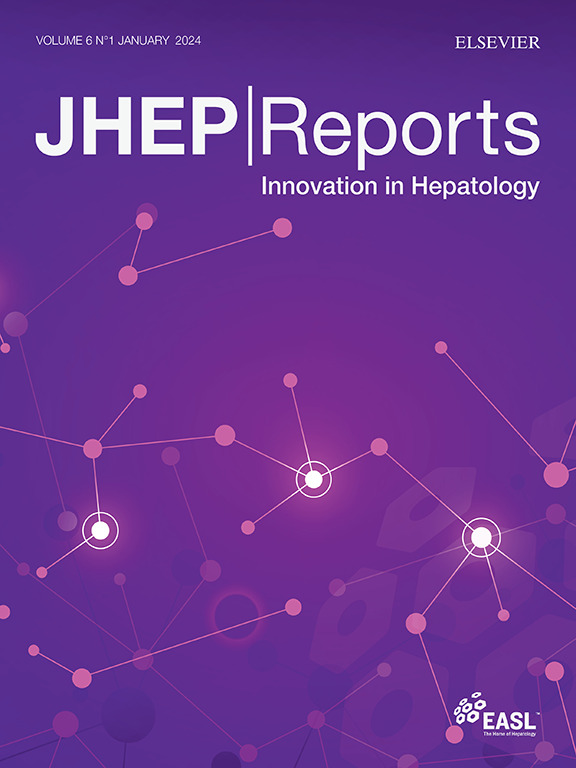A novel therapy targeting the gut–liver axis for chronic hepatitis B: Ursodeoxycholic acid plus Bifidobacterium
IF 9.5
1区 医学
Q1 GASTROENTEROLOGY & HEPATOLOGY
引用次数: 0
Abstract
Background & Aims
Targeting the gut–liver axis is a promising strategy for treating liver diseases. We aimed to assess the therapeutic efficacy of targeting the gut microbiota-bile acid (BA) axis using ursodeoxycholic acid (UDCA) combined with the probiotic Bifidobacterium to treat chronic hepatitis B (CHB).
Methods
BA profiles were characterized by mass spectrometry, and gut microbiota composition was analyzed using 16S rRNA sequencing in patients with CHB and healthy controls (HCs). The effects of UDCA and Bifidobacterium were assessed both in a preclinical model and in a 2-month clinical trial involving 22 patients with CHB who received either UDCA (250 mg twice daily; n = 6), Bifidobacterium (2 g twice daily; n = 6), or a combination of UDCA and Bifidobacterium (n = 10).
Results
UDCA was the most significantly decreased serum BA in patients with CHB compared to HCs (p <0.001), and had the strongest anti-HBV effect in vitro and in vivo. In the gut, the Bifidobacterium abundance was the most dramatically decreased fecal genus in patients with CHB (p = 0.018), and had the anti-HBV effect in vivo. Finally, combined treatment with UDCA and Bifidobacterium significantly reduced serum alanine aminotransferase (p = 0.008), HBV DNA (77% reduction; p <0.001), pregenomic RNA (59% reduction; p <0.001), and hepatitis B surface antigen (15% reduction; p = 0.002) levels. It also decreased NKG2A expression on natural killer (NK) cells and PD-1 expression on CD8+ T cells by approximately 50% (p <0.01), while enhancing secretion of granzyme B, perforin, and interferon-γ by CD8+ T and NK cells (p <0.05). These effects were superior to those achieved with either monotherapy.
Conclusions
Combined treatment with UDCA and Bifidobacterium promotes CD8+ T/NK cell function and viral control in patients withCHB and may represent a promising adjunct therapy warranting further investigation.
Impact and implications
Targeting the gut microbiota-bile acid axis has the potential to treat chronic hepatitis B. Results from preclinical models and a clinical trial show that combination treatment with ursodeoxycholic acid plus the probiotic Bifidobacterium exerts antiviral effects in patients with chronic hepatitis B by promoting CD8+ T cell and natural killer cell function. These findings may advance the understanding of HBV immunology and treatment options for chronic hepatitis B.
Clinical Trial Number
ChiCTR2200062861.

针对慢性乙型肝炎肠-肝轴的新疗法:熊去氧胆酸加双歧杆菌
背景,目的以肠肝轴为靶点治疗肝脏疾病是一种很有前景的治疗策略。我们旨在评估熊去氧胆酸(UDCA)联合益生菌双歧杆菌靶向肠道微生物群-胆汁酸(BA)轴治疗慢性乙型肝炎(CHB)的疗效。方法采用质谱法分析CHB患者和健康对照(hc)的sba谱,采用16S rRNA测序法分析肠道菌群组成。UDCA和双歧杆菌的作用在临床前模型和为期2个月的临床试验中进行了评估,该试验涉及22名慢性乙型肝炎患者,他们接受UDCA (250 mg,每日两次;n = 6)、双歧杆菌(2 g,每日2次;n = 6),或UDCA和双歧杆菌的组合(n = 10)。结果与hcc相比,sudca对CHB患者血清BA的降低作用最为显著(p <0.001),体外和体内抗hbv作用最强。在肠道中,双歧杆菌丰度是CHB患者粪便属中下降最显著的(p = 0.018),并且在体内具有抗hbv作用。最后,UDCA联合双歧杆菌治疗显著降低血清丙氨酸转氨酶(p = 0.008), HBV DNA(降低77%;p <0.001),基因组前RNA(减少59%;p <0.001)和乙型肝炎表面抗原(减少15%;P = 0.002)水平。NKG2A在自然杀伤(NK)细胞上的表达和PD-1在CD8+ T细胞上的表达均降低了约50% (p <0.01),同时CD8+ T细胞和NK细胞分泌颗粒酶B、穿孔素和干扰素-γ (p <0.05)。这些效果优于单药治疗。结论UDCA和双歧杆菌联合治疗可促进慢性乙型肝炎患者CD8+ T/NK细胞功能和病毒控制,可能是一种有希望的辅助治疗方法,值得进一步研究。影响和意义针对肠道微生物-胆酸轴具有治疗慢性乙型肝炎的潜力。临床前模型和临床试验的结果表明,熊去氧胆酸加益生菌双歧杆菌联合治疗通过促进CD8+ T细胞和自然杀伤细胞功能对慢性乙型肝炎患者发挥抗病毒作用。这些发现可能会促进对乙肝病毒免疫学和慢性乙型肝炎治疗方案的理解。
本文章由计算机程序翻译,如有差异,请以英文原文为准。
求助全文
约1分钟内获得全文
求助全文
来源期刊

JHEP Reports
GASTROENTEROLOGY & HEPATOLOGY-
CiteScore
12.40
自引率
2.40%
发文量
161
审稿时长
36 days
期刊介绍:
JHEP Reports is an open access journal that is affiliated with the European Association for the Study of the Liver (EASL). It serves as a companion journal to the highly respected Journal of Hepatology.
The primary objective of JHEP Reports is to publish original papers and reviews that contribute to the advancement of knowledge in the field of liver diseases. The journal covers a wide range of topics, including basic, translational, and clinical research. It also focuses on global issues in hepatology, with particular emphasis on areas such as clinical trials, novel diagnostics, precision medicine and therapeutics, cancer research, cellular and molecular studies, artificial intelligence, microbiome research, epidemiology, and cutting-edge technologies.
In summary, JHEP Reports is dedicated to promoting scientific discoveries and innovations in liver diseases through the publication of high-quality research papers and reviews covering various aspects of hepatology.
 求助内容:
求助内容: 应助结果提醒方式:
应助结果提醒方式:


